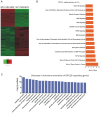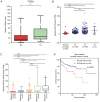Knockdown of spindle pole body component 25 homolog inhibits cell proliferation and cycle progression in prostate cancer
- PMID: 29552205
- PMCID: PMC5840511
- DOI: 10.3892/ol.2018.8003
Knockdown of spindle pole body component 25 homolog inhibits cell proliferation and cycle progression in prostate cancer
Abstract
Prostate cancer (PCa) is the most frequently diagnosed type of cancer in Chinese males. Cell-cycle aberration is a hallmark of cancer. Spindle pole body component 25 homolog (SPC25), a component of the Ndc80 complex, serves an important role in regulating mitotic chromosome segregation. However, the functional roles of SPC25 in PCa remain poorly understood. To the best of our knowledge, the present study was the first to demonstrate that SPC25 is significantly upregulated in PCa. In order to investigate the molecular roles of SPC25, a loss of function assay was performed, revealing that SPC25 knockdown inhibited cell proliferation, and induced a decrease in the number of cells in the S phase and an increase in the number of cells in the G2/M phase. Furthermore, SPC25 knockdown promoted the apoptosis of PCa cells. Additionally, bioinformatics analysis revealed multiple functional roles of SPC25 in regulating cell proliferation, apoptosis, invasion, transforming growth factor-β signaling and the SUMOylation pathway in PCa. The present study also evaluated the potential prognostic value of SPC25 using The Cancer Genome Atlas RNA-seq data and demonstrated that SPC25 was upregulated in late stage PCa. Kaplan-Meier analysis demonstrated that lower SPC25 expression was associated with an improved survival rate in patients with PCa. Taken together, these results suggested that SPC25 serves an oncogenic role in PCa and may act as a novel diagnostic and therapeutic target for PCa.
Keywords: cell cycle; prognosis; proliferation; prostate cancer; spindle pole body component 25 homolog.
Figures






Similar articles
-
Spindle pole body component 25 in the androgen-induced regression of castration-resistant prostate cancer.Transl Androl Urol. 2022 Apr;11(4):519-527. doi: 10.21037/tau-22-214. Transl Androl Urol. 2022. PMID: 35558271 Free PMC article.
-
Spindle pole body component 25 regulates stemness of prostate cancer cells.Aging (Albany NY). 2018 Nov 8;10(11):3273-3282. doi: 10.18632/aging.101631. Aging (Albany NY). 2018. PMID: 30408771 Free PMC article.
-
SPC25 upregulation increases cancer stem cell properties in non-small cell lung adenocarcinoma cells and independently predicts poor survival.Biomed Pharmacother. 2018 Apr;100:233-239. doi: 10.1016/j.biopha.2018.02.015. Epub 2018 Feb 16. Biomed Pharmacother. 2018. PMID: 29432994
-
Spindle pole body component 25 homolog expressed by ECM stiffening is required for lung cancer cell proliferation.Biochem Biophys Res Commun. 2018 Jun 12;500(4):937-943. doi: 10.1016/j.bbrc.2018.04.205. Epub 2018 May 2. Biochem Biophys Res Commun. 2018. PMID: 29709477
-
The multifaceted functions of SPC25 in cancer: from molecular pathways to targeted therapy.Front Med (Lausanne). 2025 May 7;12:1550901. doi: 10.3389/fmed.2025.1550901. eCollection 2025. Front Med (Lausanne). 2025. PMID: 40400636 Free PMC article. Review.
Cited by
-
Calcium-binding and coiled-coil domain 2 promotes the proliferation and suppresses apoptosis of prostate cancer cells.Exp Ther Med. 2021 Apr;21(4):405. doi: 10.3892/etm.2021.9836. Epub 2021 Feb 25. Exp Ther Med. 2021. PMID: 33692836 Free PMC article.
-
Spindle pole body component 25 and platelet-derived growth factor mediate crosstalk between tumor-associated macrophages and prostate cancer cells.Front Immunol. 2022 Jul 27;13:907636. doi: 10.3389/fimmu.2022.907636. eCollection 2022. Front Immunol. 2022. PMID: 35967419 Free PMC article.
-
Spindle component 25 predicts the prognosis and the immunotherapy response of cancers: a pan-cancer analysis.Sci Rep. 2024 Apr 11;14(1):8452. doi: 10.1038/s41598-024-59038-y. Sci Rep. 2024. PMID: 38605119 Free PMC article.
-
A Combined Systemic Strategy for Overcoming Cisplatin Resistance in Head and Neck Cancer: From Target Identification to Drug Discovery.Cancers (Basel). 2020 Nov 23;12(11):3482. doi: 10.3390/cancers12113482. Cancers (Basel). 2020. PMID: 33238517 Free PMC article.
-
Understanding the Genetic Landscape of Gestational Diabetes: Insights into the Causes and Consequences of Elevated Glucose Levels in Pregnancy.Metabolites. 2024 Sep 20;14(9):508. doi: 10.3390/metabo14090508. Metabolites. 2024. PMID: 39330515 Free PMC article. Review.
References
-
- Ciferri C, Pasqualato S, Screpanti E, Varetti G, Santaguida S, Dos Reis G, Maiolica A, Polka J, De Luca JG, De Wulf P, et al. Implications for kinetochore-microtubule attachment from the structure of an engineered Ndc80 complex. Cell. 2008;133:427–439. doi: 10.1016/j.cell.2008.03.020. - DOI - PMC - PubMed
LinkOut - more resources
Full Text Sources
Other Literature Sources
